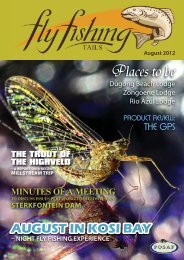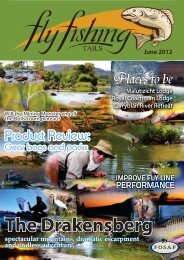MAURITIUS - Flyfishingtails
MAURITIUS - Flyfishingtails
MAURITIUS - Flyfishingtails
You also want an ePaper? Increase the reach of your titles
YUMPU automatically turns print PDFs into web optimized ePapers that Google loves.
How to:<br />
Start Building Your Own Fly<br />
Ever thought of building<br />
your own fly-rod? This could<br />
be just one of the hobbies<br />
that sprout out of the marvellous<br />
sport of Fly Fishing, your own<br />
custom built rods.<br />
I know it sounds difficult, but with<br />
a little research, practice and a<br />
good measure of patience, you<br />
will be capable to build a rod that<br />
can be the envy of your friends.<br />
There are also a lot of benefits to<br />
constructing and designing your<br />
own rod. Most importantly it can<br />
save you a lot of money, as it is<br />
often cheaper to build a rod according<br />
to your own specs.<br />
This includes the colour of the<br />
wrapping, the casting action,<br />
length of the blank and the<br />
respective components to add to<br />
the completed product. Secondly<br />
you will find it very rewarding<br />
when you start catching your<br />
first fish with the fly rod you have<br />
designed and built by yourself.<br />
Before purchasing your rod blank,<br />
you have to research what blank<br />
you would like to use for the new<br />
rod. You got to consider the various<br />
characteristics of each blank,<br />
like the rod action which comes<br />
in slow, intermediate or fast, this<br />
naturally will all depend upon<br />
your casting style.<br />
Then you must decide what rod<br />
components you want. Depending<br />
on the size of your hand,<br />
you got to consider the various<br />
custom cork grips available on<br />
the rod builders market today.<br />
You can purchase the raw grip<br />
and mould it yourself, or just<br />
order the completed product that<br />
comes in different contours like<br />
full wells, reverse-half wells, cigar<br />
and super fine.<br />
Now we got to look at the<br />
reel seat to complete the grip<br />
arrangement. Again there are<br />
countless alternatives available<br />
to pick from. These reel seats<br />
are constructed from different<br />
exotic woods, metals and other<br />
synthetic materials. They come in<br />
configurations like down-locking,<br />
up-locking and also sliding rings<br />
for the very light rods.<br />
This is followed by the stripping<br />
guide, a set of guides (where the<br />
fly line winds through) and a correctly<br />
sized tip top to fit the rod<br />
tip thickness. You can choose between<br />
single foot or snake guides<br />
depending if you are going to fish<br />
for light or heavy fish.<br />
The guides come in light wire, ceramic<br />
or titanium coated versions.<br />
The light wire snake guides are<br />
the best option for your very light<br />
rods. You can also opt for a hook<br />
keeper to keep the fly in place<br />
when not casting.<br />
To complete and fit all the components<br />
to your new customized<br />
rod you’ll require wrapping<br />
thread in the color of your choice<br />
and rod wrapping varnish to coat<br />
the thread.<br />
Look for good rod builders’ epoxy<br />
to put together the rod seat and<br />
bonding the reel seat and cork







